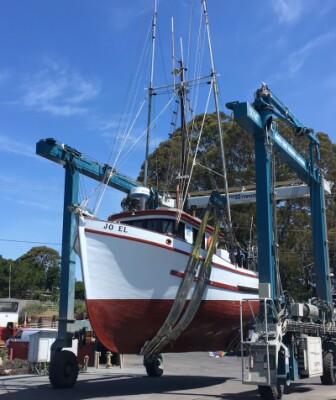Despite the fact that fishermen work in the first or second most dangerous occupation — depending on who you talk to — fishermen can be very casual about the risks they face daily.
So I was not surprised when last week's Maine Fishermen's Forum had a seminar on Saturday titled "Reducing Risk on Deck in the Lobster Fishery" and only about 25 people showed up — eight of them fishermen.
Jennifer Lincoln, the head of NIOSH's Alaska Pacific office, moderated the session. Over a number of years, she and her staff have gone to great lengths to document fatal and non-fatal injuries in the business of commercial fishing.
Jennifer Lincoln, head of NIOSH’s Alaska office, traveled to the Maine Fishermen’s Forum to moderate a discussion about ways to lower lobstermen’s risk of falling overboard. Kelley Drew/Ginger Snaps Studios photoLincoln talked about the gathering of that information and, focusing on the Pacific Northwest, some of the things they have done to reduce those numbers. They include the E-Stop, which allows someone wrapped up in a seine winch to immediately shut it off and getting more fishermen to wear PFDs.
Saturday's session, she said, was to be an exchange of information, and the first speaker, researcher Scott Fulmer of the University of Massachusetts Lowell, set the tone. Fulmer, who has conducted ergonomic studies among Bay State fishermen, began by telling the audience, "What we are getting at today is problem solving."
Starting with a photo of a waitress in a torturously painful posture, he pulled the audience into the discussion by getting them to talk about what was wrong in the photo and what could be done to make her job easier.
From there he and the audience went on an ergonomic job analysis of life on deck, with fishermen in the audience describing their own problems.
"Where does it hurt?" Fulmer asked.
"It starts at the wrist, works up to the elbows and the shoulders," said one fisherman.
"Both shoulders and the lower back," said another fishermen.
That was followed by suggestions for reducing ergonomic risk factors.
Francis Coulombe, of the Quebec Fisheries & Aquaculture Center, and Sylvie Montreuil, of Laval University in Quebec City, Quebec, followed Fulmer. They presented an analysis of a study on risk and prevention of fishermen falling overboard from Quebec lobster boats.
Out of 50 incidents, lines on deck accounted for nine people going over board, while 12 went after losing their balance.
Improved line handling was high on the list of ways to prevent going overboard, but so were "cohesion among crew members" and a deck with a non-skid surface.
On a scale of 1 to 10 ranking factors to prevent lobstermen going overboard, line control came in at 6.2, while, surprisingly, captain's attitude was 6.4.
The 25 or so people attending the seminar seemed to get some good information. It's too bad more were not there. After all, it's not as if Maine lobstermen are immune from risk. A story in the Feb. 13, 2014, Portland Press Herald was entitled "Maine lobstermen fall overboard more often than people may think." In the story, David Cousens, president of the Maine Lobsterman's Association, said he had gone over twice, with the rope wrapped around his feet both times.
Oh, well, maybe more will attend next time. Though hopefully it won't take some deaths in Maine's lobster fleet to bring fishermen to the next seminar.







